It’s been a while since I’ve written anything here. My grandfather passed away last month and that took a lot of my blogging energy away from me. I knew I wanted to dedicate a post to him as he was as much a foodie as I am, but my words escaped me. In my failed attempts to write, I would stare blankly at my computer screen as memories of him streamed through my thoughts.
When I slept over my grandparent’s house as a kid, I would often hear my grandfather poke around in the kitchen, usually around dawn, well aware that my grandmother could sleep through anything. I, of course, would get up from bed to find him alone in the kitchen, happily stirring a hefty pot of homemade jam (his specialty) or preparing some sort of sweet treat without my grandmother there to convince him against it. When he noticed me watching he would let out big a smile, and allow me to stay and help so long as I didn’t wake up anyone else.
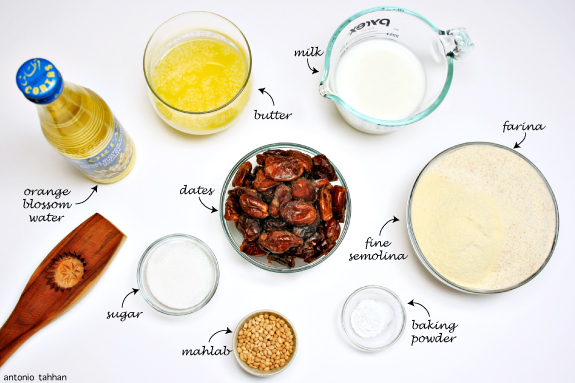
Since I haven’t yet perfected my grandfather’s rose petal jam (مربة الورد), his claim to fame, I decided to make one of my favorite cookies I grew up eating called ma’moul (معمول). If you’re Arabic, these cookies need no introduction as they’re popular all around the Middle East, where they’re stuffed with either walnuts, pistachios, or pureed dates.

The cookie itself tastes a lot like butter cookies, but these also have more of a crumbly, shortbread texture because of their semolina base.
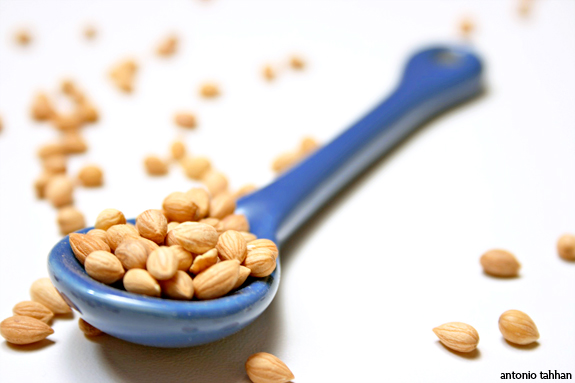
The secret ingredient that makes these cookies so special is called mahlab, which is an aromatic spice obtained by extracting the seed kernels from inside the cherry stone of the St. Lucie Cherry. It’s very popular in countries like Greece, Turkey and all around the Middle East.
note: Since I won’t be able to host this month’s A Taste of the Mediterranean, I want to give away some mahlab to three randomly chosen commenters on this post (by May 1st). If you’d like to share, I’d love to know how family plays a roll in your cooking since it is something I have given a lot of thought to this month. Thank you for your support and understanding.
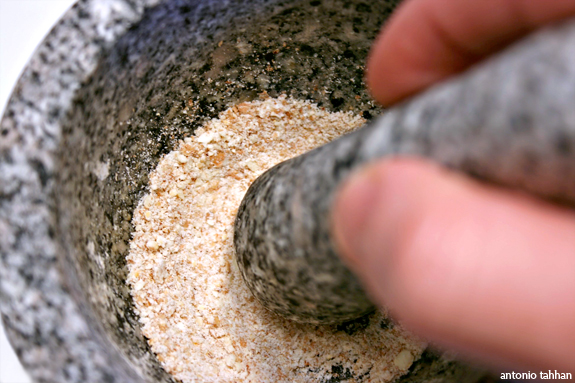
The mahlab gives these cookies a subtle nutty flavor that you won’t pick up on immediately, but you’ll certainly notice if it’s missing. Mahlab is also very popular in Turkey and Greece for flavoring egg-rich breads similar to challah in Jewish cuisine.

As with most Middle Eastern dishes, these cookies take some patience. If you don’t have Middle Eastern cookie molds laying around, you could use any circular molds, or you could even free-hand them like Kate from Aaplemint did. Anyway you form them, they’ll look beautiful and taste amazing.
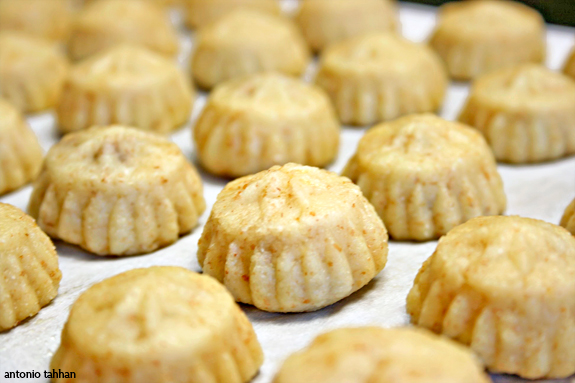
Funnily enough, I wish I had a pair of pantyhose when I ventured to make these cookies. While visiting the Middle East last winter I learned that some women have a pair of clean pantyhose set aside that they use especially for removing these cookies from their mold. That way you don’t spray the mold with anti-stick spray or bruise your hand in the process, like I did.
ma’moul
yields approx 50-60 small cookies
Components
- 300 g fine semolina
- 100 g coarse semolina
- 350 g pitted dates
- 175 g unsalted butter + 1 tsp
- 2 tbsp sugar
- 1 tbsp + 3 tsp orange blossom water
- 1 tbsp mahlab, ground
- 1/2 tsp baking powder
- powdered sugar, for garnish
Putting them all together
- Combine the semolina, ground mahlab, and sugar. Melt the butter in a small saucepan and pour over the semolina mixture while hot. Rub the grains of semolina against your hands so that each grain is well coated with butter. Repeat this for 5-7 minutes. Cover and let sit over night.
- To make the filling, process the pitted dates with the remaining tbsp of melted butter and 1 tsp of orange blossom water in your food processor until it becomes a smooth paste.
- Mix the remaining orange blossom water with the semolina mixture and knead until it becomes a dough.
- Form each cookie with a mold or freehand as shown in the photo above (by hiding a ball of the date filling inside the dough).
- Place on a parchment-lined baking sheet and bake in a 325 degree F oven for 25-30 minutes or until the bottom is golden brown.
- Cool the cookies on a cookie sheet and sprinkle with powdered sugar for garnish.
notes: Cream of Wheat (aka Farina) should be available at all major supermarkets. For these cookies I use the red box that says 2 1/2 minutes.
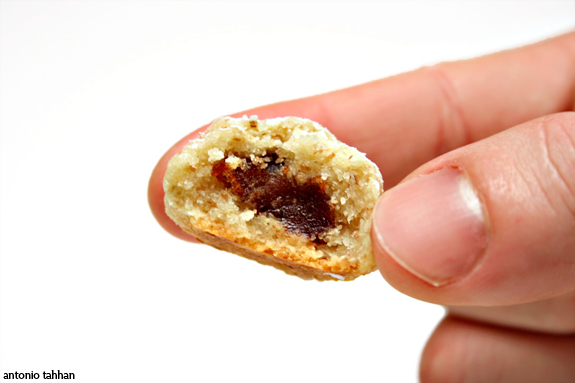
What a gorgeous recipe and post.
I’m hellbent on making these.
Cheers!
Sorry for your loss… may he rest in peace ,with an amazing recipe like this no one can will ever forget him. thanks for sharing and once again sorry.
Great to come across your site…wonderful stuff you are doing.
Oh my gosh!…the panty hose advice worked incredibly well! The difficulty in getting the mamoul cookies out of the mold discouraged me from baking these cookies! (Note that I used knee high stockings 🙂 I just placed the mold partway in so that the band was at the edge of the mold area so that all I needed to do was pull up on the band to pop them out. Again…just amazing!) Thank you so much for this!
hi, I just came across your blog. it is Amazing. very precise and to the point. I just wanted to know what is cream of wheat or farina? can I substitute for coarse semolina or all purpose flour? I live in Asia we don’t have anything by name of cream of wheat
Thanks so much for sharing this, I just bought a large plastic ma’moul cookie mold at the Souk in my town in Northern israel, and so happy to have found photos and a recipe to use it. Plus that panty hose trick is so helpful.
Dear Tony,
This weekend a new beautiful Syrien groceryshop has opened and now all the ingredients for mahmool coockies are available around my corner 🙂 I came across your recipe and I would like to try to make my coockies this way. In Holland they do not sell the butterstick. Can you estimate how much grams of butter I will need for your coockies? Thank you so much for sharing and have a nice day!
Dear Wilma! I updated the recipe to include the measurement of butter in grams. Thanks for the feedback! Let me know how the cookies turn out. Have a wonderful day!
Good morning from Indianapolis! I’m confused about the two separate listings for fine semolina; one for 300 grams and another for 100 grams. Does it just mean to use 400 grams? I’m making them for a homesick Saudi friend, studying here, and want to bring him a special homemade treat. Thank you.
Hi Lauren! Sorry, that was a typo. It’s supposed to be 100 g of coarse semolina. If you can’t find coarse semolina, you can prepare this recipe entirely with fine semolina. That’s very nice of you to do. Let me know how they turn out!
And when do you add the milk? It’s in the ingredients but not the instructions…
Hi Ashley— I no longer use milk. Only butter. I had updated the recipe, but didn’t take a new photo of the ingredients without the milk. The recipe works great though. Let me know what you think!